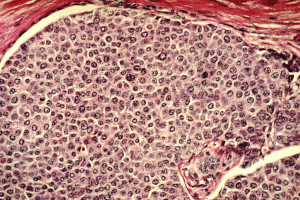By Mien Nguyen ’22

Breast cancer cells (the cells with circular shapes in them) on a microscope slide, visibly prevalent in the tissue. Source: https://commons.wikimedia.org/wiki/File:Breast_cancer_cells.jpg
A research study published recently at the University of Washington School of Medicine led by Greg Findlay has discovered close to 4,000 distinct mutations in the human BRCA1 gene, which is thought to be a primary cause of breast cancer. The objective of this study was to facilitate and increase the accuracy of breast cancer diagnoses by establishing a database of BRCA1 mutations that contained information on whether each would be problematic for the patient’s health (1).
Breast cancer is a disease caused by genetic mutations that trigger cells in the breast tissue to continuously divide without regulation. Breast Cancer is often treatable in its early stages by procedures such as tissue removal. However, breast cancer but can become lethal as the it progresses spreads to other body parts (2). It is therefore crucial that breast cancer is diagnosed early so that patients can have the option of treating it (1).
However, early cancer diagnoses can be impossible to achieve, given the ambiguity of the disease. The BRCA1 gene, having been rigorously studied for decades, remains an enigma to the scientific and medical communities. While it is known that certain mutations in this gene can cause cancer, many of these mutations act via unknown mechanisms, making it impossible to correctly predict their effects. Consequently, when a patient undergoes genetic testing to check whether they have breast cancer, results can often be inconclusive, indicating the presence of a BRCA1 mutation that is of unknown risk (1).
The absence of knowledge regarding mutant BRCA1 mechanisms calls for a better understanding of the risks associated with every variant of the gene. To solve this issue, researchers used saturation genome editing and CRISPR technology, a modern and popular method of altering the sequence of the genome to induce numerous, small-scale mutations in important sections of the gene and to assign a degree of importance to each one (1, 3).
Since the researchers found that the behaviors of the cell cultures “reflect with surprising accuracy what happens in a person,” they were able to classify the mutations as either harmful or benign in a patient. This information was added to the Brotman Baty database to aid in clinical assessments (1).
Moving forward, researchers hope to perform the same technique on the remaining portions of the BRCA1 gene, a process predicted to take a few years, so that the database can continue expanding. The implications of this study, according to Findlay, are not confined to breast cancer, and should be applied to other diseases that can severely impair a patient’s health and livelihood (1).
References:
- University of Washington Health Sciences/UW Medicine. (2018, September 12). Thousands of breast cancer gene variants engineered and analyzed: Findings will be immediately useful to many patients with previously inconclusive genetic test results. ScienceDaily. Retrieved September 24, 2018 from sciencedaily.com/releases/2018/09/180912133458.htm
- Breast cancer: Overview. (n.d.). Retrieved September 24, 2018 from https://www.ncbi.nlm.nih.gov/pubmedhealth/PMH0072606/
- Findlay, G. M., Daza, R. M., Martin, B., Zhang, M. D., Leith, A. P., Gasperini, M., … & Shendure, J. (2018). Accurate classification of BRCA1 variants with saturation genome editing. Nature, 1.